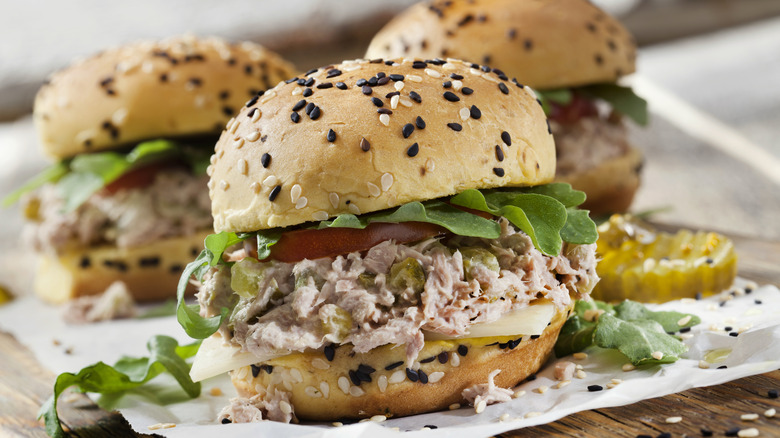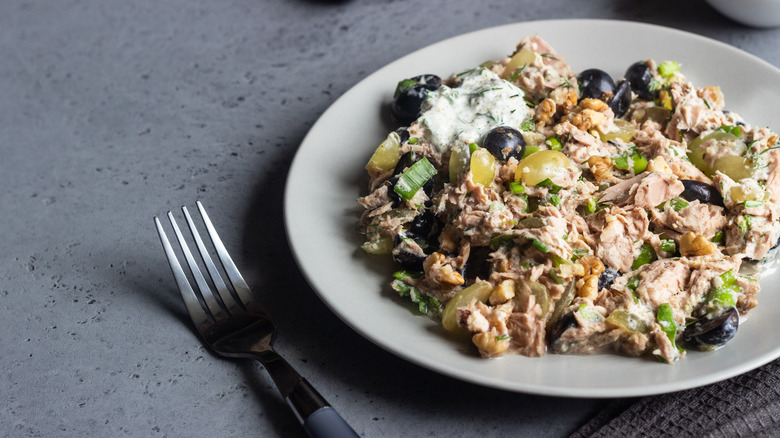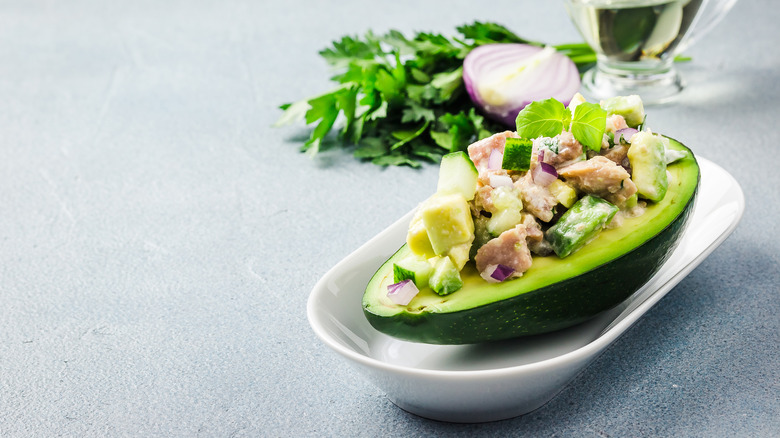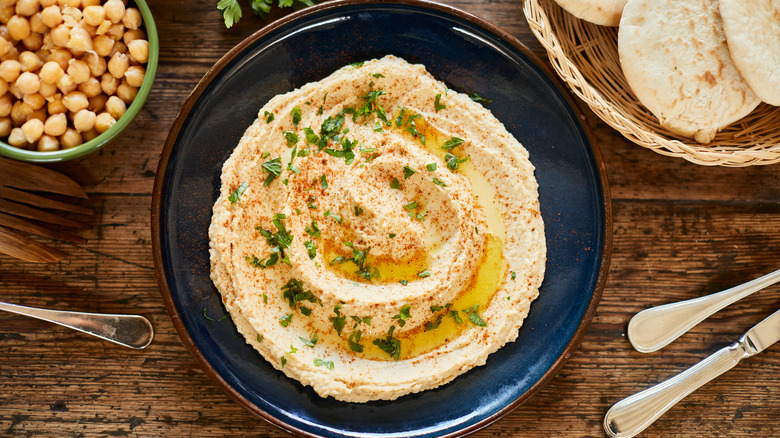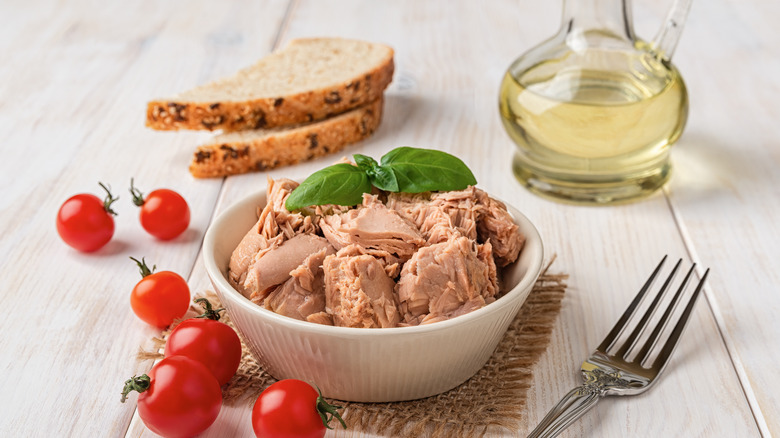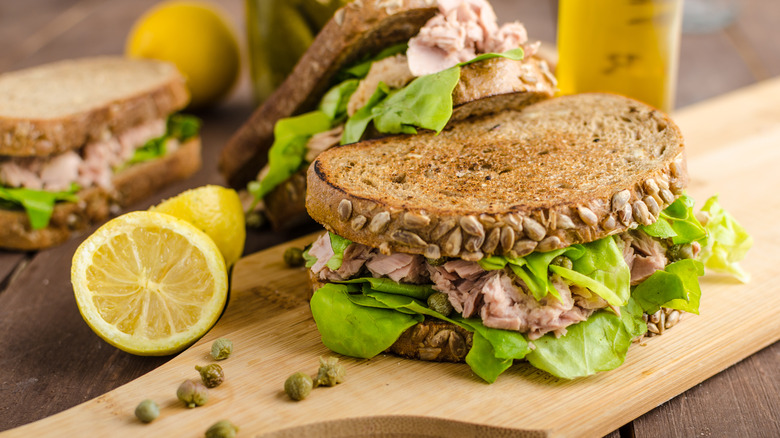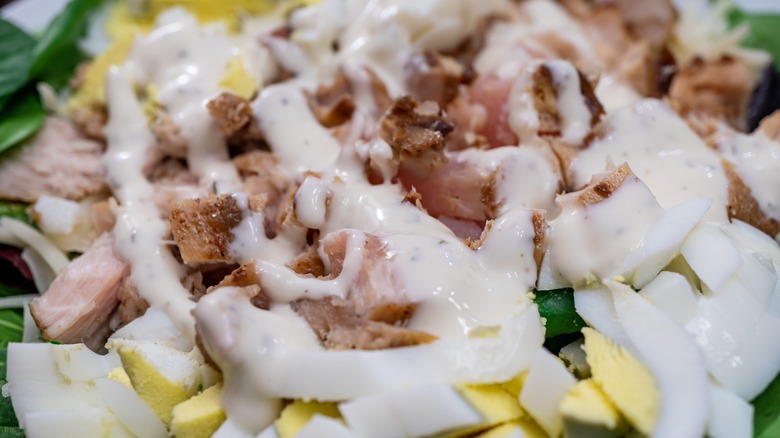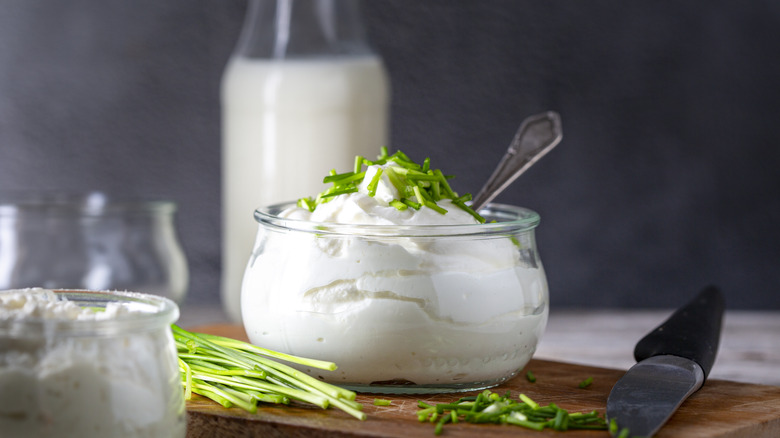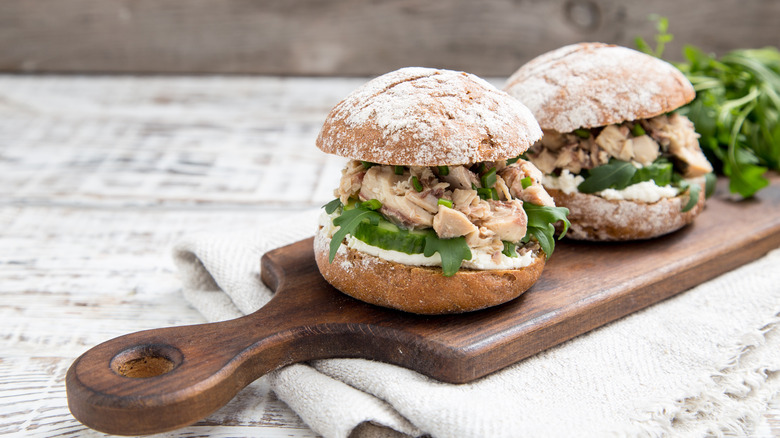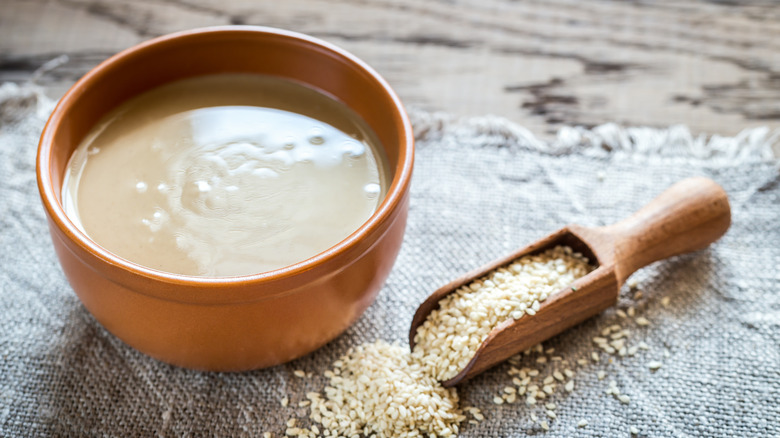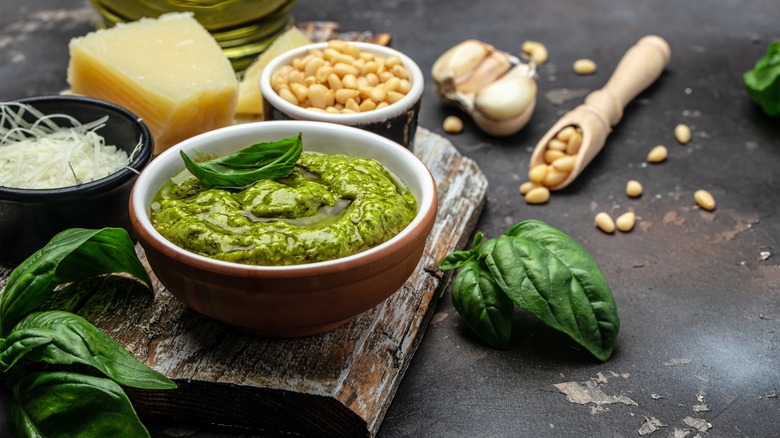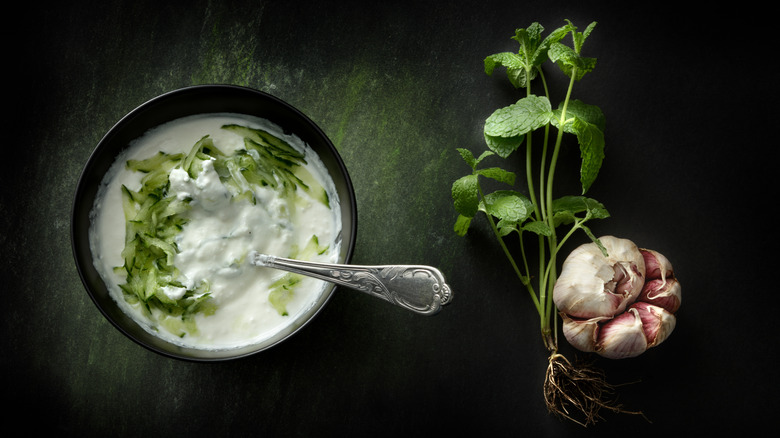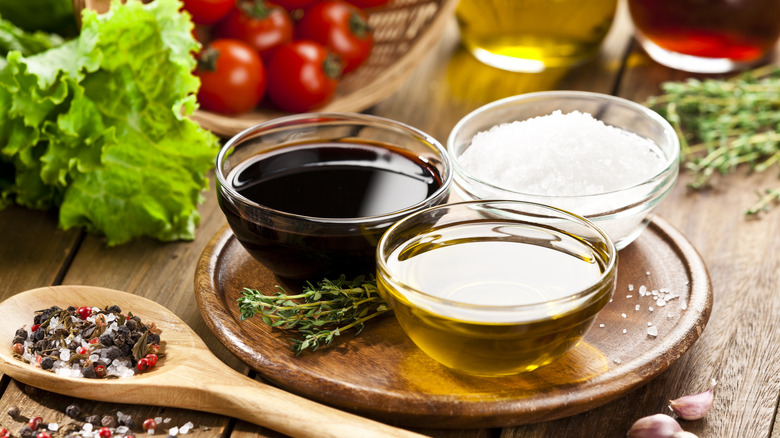12 Delicious Substitutes For Mayo In Your Tuna Salad
Most of us have experienced the tragedy of a sad tuna salad sandwich: a watery mess mixed with greasy mayo served between pale slices of white bread. That's too bad, of course, since canned tuna is affordable, readily accessible, and quite nutritious. The average can of chunk light tuna (packed in water) contains around 20 grams of protein and 1 gram of fat (or less) alongside several vitamins and minerals. In other words, this canned seafood is both nutrient-dense and delicious.
Now, some may find canned tuna to be a fairly boring, humdrum option — but it doesn't have to be. If you've never considered alternate preparation methods for this lunchtime staple beyond mayonnaise, you may want to take some time to explore new ways to perk up the midday hero.
After all, when it comes to tuna salad, you don't have to stick to mayo. In fact, with a few clever swaps, you can expand your repertoire — and find yourself falling in love with your tuna sandwich again. When you're ready to elevate your next lunch or dinner, here are 12 delicious substitutes for mayo in your tuna salad.
Greek yogurt
Greek yogurt offers a creamy, tangy, and nutritious substitute for mayonnaise in tuna salad. Greek yogurt has a thicker and creamier texture than regular yogurt and contains more protein. Between that and the dairy product's relatively similar consistency to mayo, it's easy to see why Greek yogurt is an excellent choice for anyone seeking a less nutritionally detrimental tuna salad.
There are several different ways to use Greek yogurt as a mayo substitute when making your next batch of tuna salad. For a more traditional swap, combine canned tuna, a tablespoon or two of Greek yogurt (depending on how dry or moist you like your tuna salad,), diced celery, diced red onion, a squeeze of lemon juice, and your favorite herbs or spices. Another delicious variation can be made by adding grapes for a touch of sweetness and crunch, which balances nicely against the tang of Greek yogurt (and adds a little bit of luxury to each bite).
Avocado
Mashed avocado Is a nutritious choice that can add a rich, buttery texture (and a substantial serving of healthy fats) to your tuna. With 10 grams of fiber, a bump of protein, low sodium, and no cholesterol? Avocados are a great choice for anyone looking to add big flavor and additional nutrients to their tuna. Of course, avocado is not a low-calorie food, so be mindful of how much you add if you're trying to keep your calorie consumption low.
For an easy anytime snack, slice an avocado in half and remove the pit. Next, use a fork to mash the avocado inside its skin, then add the drained canned tuna, a squeeze of lemon, and some salt and pepper. Hot sauce will be right at home, too, and you can eat this meal straight out of the skin.
If you want to get a little more involved and add some flair, try incorporating diced red onion and tomato into your mashed avocado tuna salad. Try using lime juice instead of lemon, and maybe add a sprinkle of garlic powder and some finely diced jalapeño if you like. Avocado and tuna salad also taste great with the addition of capers, which you can serve with multigrain crackers or on pumpernickel toast points.
Hummus
On its own, hummus is often a garlicky, savory spread that has tons of protein, fiber, and calcium (and very little fat). But when you add this chickpea-based spread to tuna instead of mayonnaise, you'll find both tuna and hummus work well with the other to build layers of flavor.
Seeing how tuna and white bean salad is a classic lunch combo, it makes perfect sense the bean-based Mediterranean spread also pairs so well with canned tuna. You can combine canned tuna with hummus, chopped cucumber, cherry tomatoes, and chopped fresh parsley to keep the salad light and fresh.
If you're looking to further control the flavor, try making your own hummus at home. This lets you highlight the tastes you enjoy (and minimize those that aren't your favorite). For example, some people enjoy a more garlic-forward hummus, while others prefer the taste of chickpeas, tahini, or lemon. You can also mix up the beans when making hummus, like swapping in cannellini beans. Then, add toasted and puréed nuts (cashews work well), and finish with some chopped cilantro for a burst of herb flavor.
Olive oil
Let's get one thing straight right away: Olive oil may provide healthier fat than what's present in mayonnaise ... but it's not a low-calorie food by any stretch. In other words, this substitution is more of an indulgent swap than a calorie-cutting measure. That being said, drizzling extra virgin olive oil into your tuna salad can imbue a level of flavor that's just not possible with store-bought mayonnaise.
Now, you can certainly buy canned tuna that's packed in oil, but the quality of the oil won't be as high as the one you add yourself (and may be too oily for some people). Additionally, you don't need much olive oil to make a big impact. Just 1 tablespoon per can of tuna will get you where you want to be — especially when you add other ingredients.
Olive oil with Dijon mustard, capers, and lemon mirrors a traditional vinaigrette, which can highlight the peppery bite of a high-quality oil. Chopped sun-dried tomatoes are also a good way to add a citrus kick to tuna salad alongside olive oil. Don't forget chopped fresh herbs like parsley and tarragon, as well as chopped pickles and fresh dill.
Dijon mustard
If you like a spicy flavor with any kind of canned fish, Dijon mustard is an excellent substitution for mayonnaise. Available in silky smooth or coarse varieties, Dijon mustard is named for the region in France from which it hails. Like its culinary cousin, Champagne, Dijon mustard is exclusively produced in that city, with other Dijon-like mustard varieties (those produced outside the region) generally labeled as spicy brown.
Regardless of its provenance, the best Dijon (or spicy) mustard for tuna salad is one with limited ingredients, like white wine, vinegar, and mustard seeds. There's no need to complicate this flavorful substitution, after all. It's also possible to make your own spicy mustard if you can't find authentic Dijon using a bit of elbow grease.
You can also use dried mustard powder if needed, though this means you'll need to add another liquid (such as a splash of olive oil). Other items that nicely complement Dijon mustard in tuna include finely diced shallots, parsley, and lemon juice, while pickles (both sweet and sour) add an interesting snap to this mayo stand-in.
Ranch dressing
In the seemingly never-ending battle between parents and their children to eat vegetables and other healthy foods, ranch dressing is the white flag that brings everyone to the table in peace. With a creamy, mild flavor, ranch dressing can even entice the most discriminating eaters to try new things — which is why it's a great substitution for mayonnaise in tuna salad.
Ranch dressing has a familiar taste and texture that marries well with virtually anything, and canned tuna is no exception. Of course, while you can make homemade ranch dressing to hone in on the flavor profile you prefer, you can easily head to the salad dressing aisle and pick up a bottle instead.
You don't need more than 2 tablespoons of ranch dressing per can of tuna. From there, anything that typically goes well with ranch dressing will pair nicely with tuna salad, as well. Fresh chopped cucumber, diced red onion, and a slice of tomato are perfect additions to make an easy midday sandwich. If you're not making snacks for kids, freshly cracked black pepper and a few chopped capers will elevate your meal.
Sour cream
Sour cream and yogurt are similar in flavor and texture, but the way they get there differs. While yogurt is fermented to produce its signature tangy taste, sour cream has lactic acid added to create its thick, silky texture. Sour cream's flavor is milder than yogurt, as well, and it's typically thicker than regular yogurt, too (though sour cream's texture mirrors Greek yogurt). Frankly, because sour cream feels more luxurious than yogurt, it makes for a more distinctive addition to your tuna salad.
Now, you can certainly treat sour cream the same way as Greek yogurt when it comes to replacing mayo in tuna salad. But why not take this opportunity to go upscale? Add caviar and serve your tuna on a blini or potato pancakes with a squeeze of lemon. If you want to keep your snack more down to earth, mix in some chopped chives and celery, then tuck it into a pita pocket with a slice of tomato.
Cottage cheese
Cottage cheese is having a bit of a moment in the 2020s. It seems everyone is adding cottage cheese to pretty much everything from desserts to savory snacks — so why would tuna salad be any different? Cottage cheese is available in large and small curds, with some brands offering a thicker texture than others. Either way, jump on this high-protein, low-calorie bandwagon and add cottage cheese to your canned tuna instead of mayonnaise.
When it comes to substituting cottage cheese for mayo in tuna salad, the size of the curd doesn't matter since it'll be blended smoothly before adding. Place half a cup of cottage cheese in a food processor and pulse until smooth. You won't necessarily use the entire half cup, but it's nice to have some extra cottage cheese on hand to substitute for other recipes as needed.
Once your cottage cheese is blended, add it to your canned tuna in any amount you desire. The flavor of cottage cheese is mild and can be customized to your taste. Diced bell peppers and chopped scallion make for good additions here, as does a dash or two of your favorite hot sauce.
Tahini
Tahini is a basic ingredient made from toasted sesame seeds, which are blended with high-quality olive oil and a little salt until smooth. The flavor is slightly bitter, nutty, and redolent of the highly flavored cooking of the Middle East. Tahini is used to make hummus and falafel, but it can also be an unusual and flavorful substitution for mayonnaise in tuna salad.
The underlying bitterness of tahini brings out the tuna's subtle sweetness for a lovely symbiotic flavor enhancement of both. You'll need a deft and delicate hand here, though, as too much tahini will easily overwhelm the other flavors. To be safe, add a little tahini at a time then blend with other ingredients (such as a drizzle of sesame oil and a squeeze of lemon juice or zest).
Typically, other uncommon spices and seasonings that work well in Middle Eastern cuisine will work here, too. A little za'atar or sprinkle of sumac will add a beautiful note when served with chopped cucumbers, tomatoes, a little red onion, and warm pita bread.
Pesto
Pesto is not just for pasta and pizza. In fact, the sauce is the perfect substitute for mayo in tuna salad. The herbaceous flavor is a raft upon which the savory tuna floats, bobbing through resin-y pine nuts, sharp garlic, and a finishing touch of parmesan cheese. If you're making pesto at home, use the best-quality olive oil for a peppery bite, and make sure you add the right amount of salt. You aren't looking for an overpowering salty flavor, after all (and parmesan is salty, too), so season after blending ingredients.
Use just a tablespoon or two of pesto per can of tuna, and try using it as the foundation to build a tuna-based Caprese salad. A drizzle of rich, high-quality balsamic is an excellent addition here, as is a slice of perfectly ripe summer tomato. Or head in a different direction and pair your pesto tuna salad with roasted red peppers and a squirt of spicy mustard, or some chopped apples for an unexpected twist.
Tzatziki
Tzatziki combines tangy Greek yogurt and crunchy fresh cucumber with fresh dill and minced garlic. Even an easy-to-make-tzatziki sauce is bright and refreshing, which makes perfect sense given the often hot temperatures of its Mediterranean origins. Unsurprisingly, tzatziki's smooth yogurt and chopped cucumber provide a delightful textural contrast to tuna salad, too.
When you combine tuna with tzatziki, you eliminate any highly processed oils used in store-bought mayonnaise — replacing them with healthier yogurt and plenty of garlic. All nutrition aside, though, this combo just makes sense. It goes beyond the addition of simple yogurt and allows the incorporation of some fresh, crunchy vegetables.
Open up a pita pocket and stuff it with a tzatziki tuna salad, more cucumber, fresh tomatoes, and a handful of roasted chickpeas. Add some chopped fresh mint for a hint of brightness, or consider adding a little lemon zest if you're making your tzatziki at home.
Balsamic vinaigrette
The word balsamic is often applied in the U.S. to any type of vinegar that is dark and syrupy. But realistically? Fewer U.S. residents have had authentic balsamic vinegar than you might imagine. Genuine balsamic vinegar is only manufactured in the Modena or Reggio Emilia provinces in Italy, after all, and takes a minimum of 12 years before becoming the rich, syrup-like condiment rarely found on supermarket shelves. Still, don't let these details stop you from subbing balsamic vinaigrette for mayo in tuna salad.
Since there are many acceptable versions of balsamic-type vinegar in stores, there are plenty of options to make a delicious, tangy vinaigrette that pairs nicely with tuna. The olive oil and mustard used to make a traditional vinaigrette are a perfect foil for the sweet tang of balsamic vinegar — all of which work nicely when mixed with canned tuna.
Add cherry tomatoes and chopped fresh basil, as well, and serve with paper-thin slices of sweet red onion. For a warm appetizer, cut up and roast small yellow potatoes until crispy, then toss with the tuna and balsamic vinaigrette. Add croutons and chopped green pepper (for a twist on Panzanella), some thick shavings of Parmigiano Reggiano, or small balls of fresh mozzarella.

